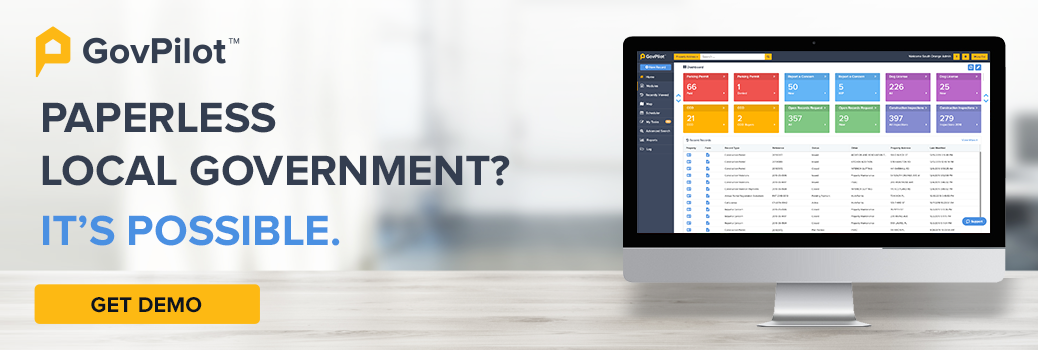This article was updated and republished on May 4, 2023.
Working in the public sector is far from easy. Budgets are limited. Expectations are high, and even as you give all your time and energy towards making a positive difference in your community, critics will always question your work.
To prove your worth to your constituents and fellow government officials, you’ll need to set various goals as a benchmark for initiatives and how much time, effort, and taxpayer dollars your efforts are taking. These metrics you’ll be setting as goals are known as government key performance indicators (KPIs.)
Here’s everything you need to know about key performance indicators for local governments, how to set goals, and how to track your performance with insightful, actionable data.
What are Government KPIs?
Key performance indicators are defined by Investopedia as, “a set of quantifiable measurements used to gauge a [government’s] overall long-term performance. KPIs specifically help determine… strategic, financial, and operational achievements.”
Goal setting with KPIs in local government is vital for elected leaders and employees to showcase their successes, make actionable improvements in the community, gauge constituent satisfaction, and to dictate where future funding and efforts should be prioritized. With limited budgets and high standards for performance, KPIs are a means for local governments to get the most out of their funds and improve efficiency across the board.
Why are KPIS for Local Governments So Important?
KPIs are vital for assessing the performance of everyone within your local government. Using trackable metrics to measure against set goals will allow local leadership to monitor performance of the county or municipality as a whole, within specific departments, and even at the individual or team level.
The key isn’t necessarily to hit every objective laid out in your KPIs. It’s to assess the efforts of government workers & elected officials to make the community better and more efficient by comparing actual results with the standard set by local government key performance indicators.
How Can Government Analytics Help to Track Progress? Here's what to consider for analyzing your KPIs effectively.
What Types of Key Performance Indicators Matter for Local Governments?
KPIs for local governments vary, as each community faces its own challenges with public priorities, budgeting, quality of infrastructure etc. That being said, here are some critical goal types your local government should be considering when setting your personalized KPIs:
1. What Are Turnaround Times for Getting Paperwork Approved?
For far too long, many local governments have been lackadaisical when it comes to getting constituents’ paperwork approved and filed. That results in delays for things like getting permits approved for infrastructure projects and businesses registered in your neighborhood.
As constituents grow more accustomed to convenience in their everyday lives (thanks Uber and Doordash!) and states like Florida and New Jersey (with more to follow) passing legislation requiring local governments to expedite permitting process, setting a high standard for application turnaround times with your key performance indicators will improve workflows and improve government-constituent relations; applicants will be happy to see their paperwork returned and approved quickly! Government leadership should be asking, how long on average does it take to review and approve applications for permits, licenses, etc.?
Going digital will make paperwork approvals drastically more efficient. Learn more about the Benefits of Making a Government Digital Transformation.
Pro Tip: Online permitting software will make it easier to track turnaround times for application approvals AND to hit your goals. Constituents won’t have to drive to the clerk’s office to file paperwork, and relevant government officials can approve or deny applications for things like business license requests, construction permit applications, pet licenses directly from their computers via the cloud. Turnaround times will also be monitored via automated timestamping, making it simple to measure performance.
2. Employee Retention: Are Employees Sticking Around?
With unprecedented challenges in recruiting government workers, a great metric for local governments to track is the average amount of time employees are sticking around within each government department.
Are government employees leaving? What is the average turnover per department and how long are employees staying on average? These KPIs for local governments will help to make sure that employees stick around and are happy with your culture.
How Can Local Governments Retain Employees? Explore our guide to find out.
3. How Much Money is Being Made via Application Fees, Fines, etc.?
Increasing revenue from application fees and fines can expand your government’s budget to get things done. As a result, a key KPI for local governments should be: how much revenue is being generated from fees and fines? How do government revenue numbers compare to previous years?
Pro Tip: Accepting online payments via your government website is a wise way to hit your KPIs by increasing application completion rates and making it easy for people that received tickets to pay their fines. Here are Popular Government Credit Card Processing Services to Consider.
4. How Long Are Infrastructure Projects Taking to Implement? Are They Coming In Under Budget?
With funding from recent legislation like the American Rescue Plan Act and Infrastructure Investment & Jobs Act, your local government should be receiving major funding to put towards your local physical and digital infrastructure. An important KPI to consider is the amount of time it is taking for an infrastructure project to be completed? Are contractors hitting their deadlines? Are projects coming in at or below the estimated budget?
These metrics will make clear how efficient your local government is when it comes to getting projects done and spending taxpayers funds.
Interested in learning more about how recent federal legislation can impact your local infrastructure? Explore these guides:
- What Does the American Rescue Plan Act Mean for Local Governments?
- What Does the Infrastructure Bill Mean for Local Governments?
5. How Much Time and Money Are Government Employees Saving Via Automation?
Most menial tasks for government workers should be a thing in the past. Government management software automates things like filing paperwork, IT ticketing, document requests and other boring administrative tasks via robotic process automation so that government workers can allocate their time on more important responsibilities.
A key metric your local government leadership should consider as a KPI is: what percentage of administrative tasks are still being performed by humans? How much time is being saved via automation? If a high percentage of tedious work is still being done by government workers, it’s a sign that your municipality or county has some work to do to adopt modern digital infrastructure.
How to Track Data for Measuring Government KPIs?
Government KPIs are meaningless if you’re not collecting measurable data to track performance with. In order to truly assess your performance, you’ll want to use government software that automatically collects data and stores it in the cloud. The real-time data is automatically pulled into customizable graphs and dashboards, meaning you’ll be able to measure actual performance against your key performance indicators in real time.
To learn more about GovPilot’s software solutions can help across government departments, schedule a free demo.

Local Government Key Performance Indicator FAQs
What Are Key Performance Indicators in Local Government?
Local government key performance indicators (KPIs) are metrics used to assess a government department’s performance when it comes to budgeting, time allocation, constituent satisfaction, and success rate for completing departmental projects.
Local leadership needs to consider goals and objectives on a monthly, yearly, and ongoing basis to measure against actual performance.
Why Do Local Governments Need KPIs?
Government key performance indicators allow local leadership to assess the performance of employees and departments against a measurable objective. For example, if you set a goal for approving permit applications in 30 days or less, and find that it takes local officials 45 days on average to approve a permit, actual performance compared to your KPI indicates that improved permit application processes are needed.
What Are Popular Municipal KPIs?
Every department in your municipality should have KPIs specific to their objectives and day-to-day responsibilities. That being said, here are some standard KPIs that are relevant across your municipality:
- How long is it taking employees to accomplish relevant tasks?
- What percentage of administrative tasks are being automated with software?
- Are departmental projects coming in under budget?
- How much money is being collected via fees and fines?
How to Leverage KPIs to Your Advantage With Your Constituents?
Don’t be afraid to let community members know about your accomplishments. Beating your goals is no easy feat with slow moving bureaucracy and limited budgets, so you deserve the credit! Be sure to leverage press releases, council meetings, and public discourse to let constituents know when your government’s hard work reaches levels beyond the goals set by governmental KPIs.
Learn more about promoting important local news via your optimized government website and government social media profiles.
Read on:






